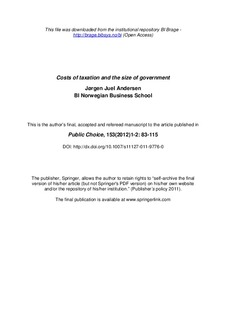| dc.contributor.author | Andersen, Jørgen Juel | |
| dc.date.accessioned | 2012-08-15T07:14:58Z | |
| dc.date.available | 2012-08-15T07:14:58Z | |
| dc.date.issued | 2012 | |
| dc.identifier.issn | 1573-7101 | |
| dc.identifier.uri | http://hdl.handle.net/11250/93390 | |
| dc.description | This is the author’s final, accepted and refereed manuscript to the article. The final publication is available at www.springerlink.com | no_NO |
| dc.description.abstract | Existing theory on the form of government suggests that a parliamentary system promotes a larger size of government than does a presidential system. This paper extends the existing theory by allowing for distortionary taxation. A main result is that if taxation is sufficiently distortionary, the parliamentary system may promote a smaller size of government than the presidential system. The proposed mechanism appears consistent with several empirical patterns in the data that cannot be explained by other theories. | no_NO |
| dc.language.iso | eng | no_NO |
| dc.publisher | Springer | no_NO |
| dc.subject | Political economy | no_NO |
| dc.subject | Constitution | no_NO |
| dc.subject | Tax costs | no_NO |
| dc.subject | Comparative politics | no_NO |
| dc.title | Costs of taxation and the size of government | no_NO |
| dc.type | Journal article | no_NO |
| dc.type | Peer reviewed | no_NO |
| dc.source.pagenumber | 83-115 | no_NO |
| dc.source.volume | 153 | no_NO |
| dc.source.journal | Public Choice | no_NO |
| dc.source.issue | | no_NO |
| dc.identifier.doi | 10.1007/s11127-011-9776-0 | |
